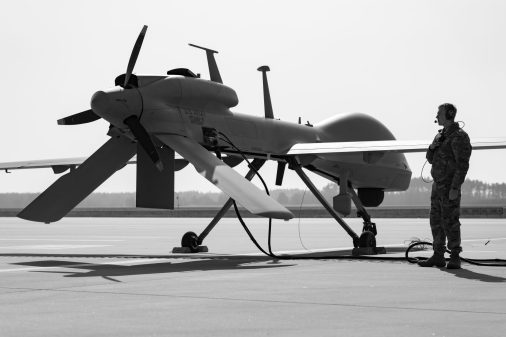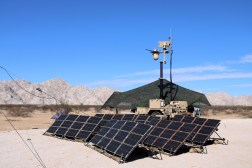Army tested electronic warfare to suppress enemy air defenses for helicopter assault

The Army used electronic jammers to evade air defenses, allowing a friendly air assault to infiltrate enemy lines during a Lethal Eagle exercise last month.
The event marked the first time the Army tested its new mobile brigade combat team concept.
That 2nd Brigade, 101st Airborne Division is the first mobile brigade combat team in the Army, serving as a test unit for what the service’s chief of staff calls “transforming in contact.”
Under that concept, the Army plans to use deployments and troop rotations to test new equipment — mainly commercial off-the-shelf gear – to allow units to be more responsive on a dynamic battlefield.
“As the Army continues to this broader transformation to a multi-domain capable, combat ready force, our division has embarked on a multiyear campaign to build a unique capability for combatant commanders and for the United States Army,” Maj. Gen. Brett Sylvia, commander of the 101st Airborne Division, told reporters Thursday. “In fact, just a week ago, we completed the first comprehensive field assessment of the Army’s transform-in-contact efforts by capitalizing on an exercise that we call Operation Lethal Eagle. And it’s based out of Fort Campbell.”
That exercise was the first time the new mobile brigade was “put through the paces” and provided the opportunity to test new technologies, prototype reorganized structures, employ multi-domain fires and mass combat power at scale, he said.
During the exercise and associated live-fire event, the unit conducted an air assault with 77 aircraft from a battalion. In order to do that, it needed to penetrate an integrated air defense system.
“We used HIMARS [artillery rocket systems], we used Apache helicopters, we used close air support, but then we also integrated both ground-based and air-based electronic warfare in order to be able to either destroy the enemy’s air defense or to suppress that enemy air defense, so that we can open up that corridor for that large helicopter force in order to be able to penetrate in and insert that ground force,” Sylvia said.
Sylvia didn’t identify the EW systems by name. However, the Army only has one aerial jamming program of record: the Multi-Function Electronic Warfare-Air Large system. This is a pod-mounted capability on a MQ-1C Gray Eagle drone capable of airborne electronic attack and limited cyber capability.
While the Army has only had quick-reaction capabilities and hasn’t fielded any program-of-record jammers to its force since the war on terror, to include MFEW, yet, its ground-based electronic jammers include the Terrestrial Layer System-Brigade Combat Team — the first integrated electronic warfare, signals intelligence and cyber platform that will be mounted on Strykers and eventually the Army Multi-Purpose Vehicle — and TLS-Manpack, the first dismounted electronic attack capability that soldiers can use to conduct jamming on the move. There is also a TLS-Echelons Above Brigade system, but that is still in the concept and prototype phase.
Army Chief of Staff Gen. Randy George has talked about electronic warfare — as part of the transforming-in-contact concept — as one of three areas where the Army needs to move faster. The other two are unmanned aerial systems and counter-UAS.
“We’re learning that the EW landscape is changing everywhere between three weeks and three months, and so that we need to be more flexible in our approach … The battlefield is changing really, really rapidly,” George said during testimony before the Senate Armed Services Committee in April.
Sylvia noted that his units and the 2nd Brigade, 101st Airborne Division must be keenly aware of their signature within the electromagnetic spectrum.
“One of the things that is most concerning to me for the division-level fight, is that if you can be seen, you can be killed. That’s not just visually seen. That is unique in your electromagnetic signature [can] be seen as well … The electromagnetic spectrum, obviously, is a key component of this fight today and will be into the future,” he said.
Personnel have to do mapping of what their footprint in the spectrum looks like, even buying commercial capabilities on Amazon such as Raspberry Pi’s, he added.
The Army writ large has begun looking at capabilities related to electromagnetic signatures of units as a key need, developing tools to tell commanders what they look like and how they can manage them.
Additionally, Syliva said he wants to be able to obfuscate or shrink what his units look like in the spectrum.
“When we’re looking at the division level of what are the capabilities that we need, we’re looking at what are those capabilities that make us smaller, more mobile, more agile, so that we can do things in order to make a division command post look more like a battalion command post, and so it doesn’t look like a lucrative target to the enemy,” he said. “For us, the big push is figuring out at the division level our communications architecture. How do we get to smaller form factors that are more reliable, more redundant, that exists out there?”
Mobile brigade combat teams
As the first test brigade to game out these new concepts and integrate new and commercial technologies, Sylvia said they’ve been given a lot of latitude.
Officials have taken existing systems and turned them into surrogates to help the Army see and understand what those systems look like in a formation.
Sylvia described how during the interwar period in the 20th century when the Army didn’t have tanks available for training exercises, it took Jeeps and placed placards on them that read “tank” as a first step toward organizing and integrating. The Army is now doing that with commercial off-the-shelf gear, placing placards that read “one-way attack systems.”
“We built some structures inside the mobile brigade combat team. We built a multifunctional reconnaissance company. That multifunctional reconnaissance company, while it doesn’t have all of the future capabilities in it, it has created a landing spot for some of those systems,” he said. “It gives our soldiers the ability to figure out how they are going to use it, it gives our leaders the capability to figure out how would they employ it, and it gives feedback back to the Army in terms of how do we need to adjust the training, how do we need to adjust the doctrine, and then what would some of that resupply look like if these systems were employed in the manner in which we think that they would be employed?”
They are also working through how to integrate these new systems in a rapid manner into operations. Most every system the military uses must be trained on and has standard procedures, doctrine and concepts for how they are employed. Constantly introducing new capabilities means units will need to understand how they integrate.
“What does a congested airspace look like? How do we do, you know, airspace control or airspace deconfliction when you’ve got these systems that are … all flying around?” Sylvia said regarding small drones.
“What are the … new capabilities that we need to give? And really kind of more importantly for us, at what echelon do we need to have that level of awareness or understanding?” he continued. “Some of these, because they are simple and intuitive, some of these UASs is we got, traditionally, we would do a weeks-long new equipment training. But many of these systems, we got them and in one to three hours, we had operators trained flying these UASs and putting them up.”
The Army needs to figure out the fragility of the systems and structures going forward.
In August, officials plan to go to the Joint Readiness Training Center to continue the Lethal Eagle efforts and stress the unit and capabilities again.






